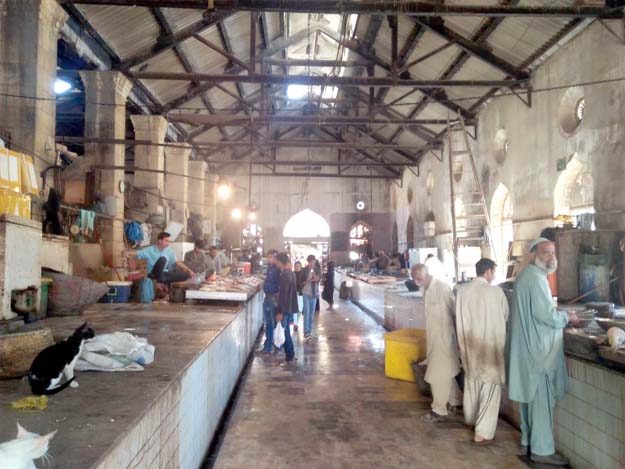How government apathy turned the grand Lea Market into a flea market
Structures are now crumbling apart, encroachments have hidden original buildings from view

Located in one corner of Lyari — the city’s oldest neighbourhood — Lea Market was once a major hub of traders and buyers in the city. PHOTOS: EXPRESS
Built in 1927, the market was divided into four two-storey buildings, with a courtyard in the centre for visitors to relax. A beautiful tower arose from one corner of the market, which housed a clock that many locals relied on to see the time.
Located in one corner of Lyari — the city's oldest neighbourhood — Lea Market was once a major hub of traders and buyers in the city. On any given day, vendors of vegetables, meat, fish and dairy products thronged the market to sell or purchase merchandise, besides the thousands of loyal customers, who came to purchase groceries.
Of the four buildings, one was allocated to dairy products, another for vegetables and fruits, the third for meat and the fourth for fish. The latter was further divided into two parts — one for fresh fish and the other for dried marine products.
Patriotism takes flea market shopkeeper to Everest
In fact, the original market only had three buildings and the meat and fish traders were housed in one building at the start. The fourth building was constructed during the reign of Ayub Khan, in which meat sellers were allocated shops. Such was the regard for the market's architecture at the time that the new building was constructed almost identical to the other three so that it wouldn't look out of place in the area.

The good old days
Senior citizens and residents of the area recount nostalgic memories associated with the market. "I used to play in the park that doesn't exist anymore," said 62-year-old Muhammad Rafiq Baloch. "There were chairs placed in the courtyard between the buildings and residents of the area used to sit there in the evenings and socialise," he reminisced.
Today, the original structure lies hidden behind illegal constructions that have cropped up around the market. There is little space for customers to navigate through the pathways that have become even more constricted due to the hawkers and pushcarts, selling all kinds of merchandise. Besides, illegal shops, which now sell shoes, have been built on the park's land as well as the courtyard.
Ahmed, a butcher who owns a shop in the meat market, told The Express Tribune that there were 72 shops in the meat market when his father ran the shop. Only 12 remain today. "There is no electricity for the last 10 years," he lamented, decrying the apathy of the relevant authorities.
Reminiscing about the market in its prime when he was just a teenager helping his father at the shop, Ahmed said that meat traders and customers from across the city would flock to Lea Market to procure the merchandise. They hardly have any walk-in customers anymore.
Again, Ahmed attributes the loss of business to the derelict condition of the marketplace.

Plans for revival?
"Let's clean it ourselves!" remarked architect Yasmeen Lari, when The Express Tribune sought her comments on the condition of the heritage buildings. Lari, the founder of the Heritage Foundation, has been an ardent advocate of the need to preserve heritage sites.
"We need to start a movement to clean heritage sites," said Lari, adding that she has recently started a campaign to clean such buildings.
According to the provincial government's data, there are 33,000 heritage and archaeological sites across Sindh, including 1,744 in Karachi alone. "This is the most recent data," said Sindh Minister for Culture, Tourism and Antiquities, Syed Sardar Ali Shah.
Karachi's DHA residents long for weekly flea market
Shah, who has recently suggested the provincial government to set up an endowment fund for the preservation and restoration of historical sites, said that the repair work is expensive for such sites. "And we don't have funds," he lamented. He added, however, that they were trying to restore some historical buildings and the Lea Market was one of their top priorities.

But the challenges, says the minister, are manifold. "Thousands of people will be affected if the government takes complete control of the market. The whole area is occupied by illegal encroachers and makeshift stalls," he explained.
Baloch, however, remains skeptical about the plans and questioned why the market was allowed to disintegrate in the first place. He accused the various government departments of being equally complicit in destroying the market. "It's a beautiful site. Restore it and see what we had built in the past," he said.
Afraid of the impending anti-encroachment drive, shopkeepers say that some officials have already warned them of the inevitability of their eviction. "It will be like the Empress Market situation," said one shopkeeper. "The state is powerful but there should be an alternative if we are forced to vacate this place," he requested.
Published in The Express Tribune, November 27th, 2019.



















COMMENTS
Comments are moderated and generally will be posted if they are on-topic and not abusive.
For more information, please see our Comments FAQ